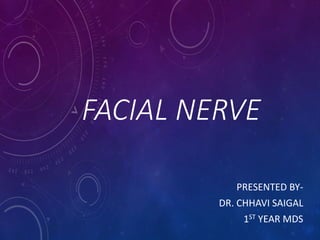
Facial nerve
- 1. FACIAL NERVE PRESENTED BY- DR. CHHAVI SAIGAL 1ST YEAR MDS
- 2. CONTENT 1. Introduction 2. Nuclei of Origin 3. Functional Component 4. Course and Relations 5. Branches and Distribution 6. Ganglia Associated with Facial Nerve 7. Applied Aspects
- 3. INTRODUCTION • Nervus facialis • Facial nerve is the 7th cranial nerve. • It is a mixed nerve with both motor and sensory roots (nerve of wrisberg). • It is a nerve of 2nd branchial arch. • It emerges from the brainstem at ponto-medullary junction.
- 4. NUCLEI • Fibres of facial nerve are connected to following nuclei - 1. Motor Nucleus (branchiomotor)-lies in lower part of pons 2. Superior Salivatory Nucleus (parasympathetic)-lies in dorsal part of pons) 3. Lacrimatory Nucleus (parasympathetic)- lower pons 4. Nucleus of Tractus Solitarius (lies in medulla) 5. Spinal nucleus of 5th nerve
- 5. FUNCTIONAL COMPONENTS GVE Secretomotor to submandibular, sublingual,lacri mal glands, palate and pharynx. SVE Muscles of facial expression and for elevation of hyoid bone. GVA Carries afferent impulses from submandibular gland, sublingual gland and lacrimal glands. SVA Taste sensation from palate and ant. 2/3rd of tongue except from vallate papilla GSA Proprioceptiv e fibres.Nerve does not give direct branches to the ear but some fibres may reach it through communicati on with vagus nerve.
- 7. ORIGIN AND INTRACRANIAL COURSE • It is attached to the brainstem at ponto- medullary junction by 2 roots- motor (large,medially) sensory(smaller,laterally) • Facial nerve leave the posterior cranial fossa by entering internal acoustic meatus.
- 8. COURSE AND RELATIONS • In the internal acoustic meatus, motor root lies in a groove on the 8th nerve with sensory root intervening. • Are accompanied by labyrinthine vessels. • At the fundus of the meatus, 2 roots fuse to form single trunk which lies in the facial canal of petrous temporal bone.
- 9. INTRA-PETROUS • After entering the internal acoustic meatus,it enters a bony canal through the roof of middle ear. • Runs laterally above the vestibule to reach antero-superior surface of medial wall of middle ear. • Bends sharply backward above the promontory.Nerve then runs horizontally backward in a canal projecting into medial wall of middle ear. • Reaching the junction of medial and posterior wall of middle ear, it is directed vertically downward behind the promontory. • It leaves the skull by passing through stylomastoid foramen.
- 10. Intraparotid/Extracranial Course- • It crosses the lateral side of base of styloid process and enters the posteromedial surface of parotid gland. • Runs forward through the gland crossing retromandibular vein and external carotid artery. • Within the parotid gland, it divides into 5 terminal motor branches.
- 11. BRANCHES AND DISTRIBUTION • Within the facial canal- • At its exit from stylomastoid foramen- Greater Petrosal Nerve Nerve to Stapedius Chorda tympani Posterior Auricular Digastric Stylohyoid
- 12. • Terminal branches within the parotid gland- • Communicating branches with adjacent cranial and spinal nerves. Temporal Zygomatic Buccal Marginal mandibular Cervical
- 14. 1. Greater petrosal nerve- Preganglionic secretomotor fibres Greater petrosal nerve joins deep petrosal nerve Forms nerve of pterygoid canal Relay in sphenopalatine ganglia zygomatic nerve joins lacrimal nerve Supplies lacrimal gland. 2. Nerve to stapedius- • It arises opposite the pyramid of middle ear. • Supplies stapedius muscle.
- 15. 3. Chorda tympani- • Arises in the facial canal about 6mm above the stylomastoid foramen. • Runs forward in a bony canal,enters the middle ear through posterior wall. Runs forward in close relation to tympanic membrane. • Enters the anterior canaliculus leaving the middle ear by passing through petro-tympanic fissure. • It then passes medial to the spine of sphenoid and enters the infratemporal fossa where it joins lingual nerve. • Carries preganglionic secretomotor fibres to submandibular ganglion for supply of submandibular and sublingual salivary glands + taste fibres from anterior 2/3rd of tongue.
- 16. 4. Posterior auricular- Arises just below the stylomastoid foramen Ascends between mastoid process and external acoustic meatus Supplies Auricularis posterior, Occipitalis and Intrinsic muscle on back of auricle. 5. Digastric branch- • It supplies posterior belly of digastric. 6. Stylohyoid branch- • Supplies stylohyoid muscle.
- 18. GANGLIA ASSOCIATED • GENICULATE GANGLIA- Located on the 1st bend of facial nerve. Sensory ganglion. • SUBMANDIBULAR GANGLIA- Parasympathetic ganglion Relay of secretomotor fibres to submandibular and sublingual glands. • PTERYGOPALATINE GANGLIA- Parasympathetic ganglion, suspended by 2 roots of maxillary nerve. Preganglionic secretomotor fibres to lacrimal gland relay in this ganglia.
- 19. APPLIED ASPECTS- Lesions of facial nerve are of 2 types- • Supranuclear or Upper motor neuron • Infranuclear or Lower motor neuron Upper motor neuron lesion- • UMN lesion spares the upper part of face because it is innervated by corticonuclear fibres of both the cerebral hemispheres. • UMN lesion results in the paralysis of only lower half of opposite side of face. Lower motor neuron lesion- • A LMN lesion causes ipsilateral paralysis of the whole side of face on same side. • Muscles in the lower part of face receive input from the contralateral hemisphere only.
- 20. Bell’s palsy- Common infranuclear lesion is bell’s palsy. Ipsilateral Paralysis of facial nerve due to its compression in facial canal at the stylomastoid foramen. • CAUSES- Infection in middle ear, compression of the nerve due to cold near stylomastoid foramen.
- 21. ACCORDING TO THE SITE OF INFRANUCLEAR LESION-
- 22. 2. Crocodile tears syndrome- • Efferent fibres from superior salivatory nucleus become improperly connected to nerve axons projecting to lacrimal glands. • Causes one to shed tears during salivation. 3. Ramsay-hunt syndrome- • Involvement of geniculate ganglion by herpes zoster results in this syndrome. • Symptoms- 1. Hyperacusis 2. Loss of lacrimation 3. Loss of sensation of taste in anterior 2/3rd of tongue. 4. Bell’s palsy and lack of salivation. 5. Vesicular rash on external ear.